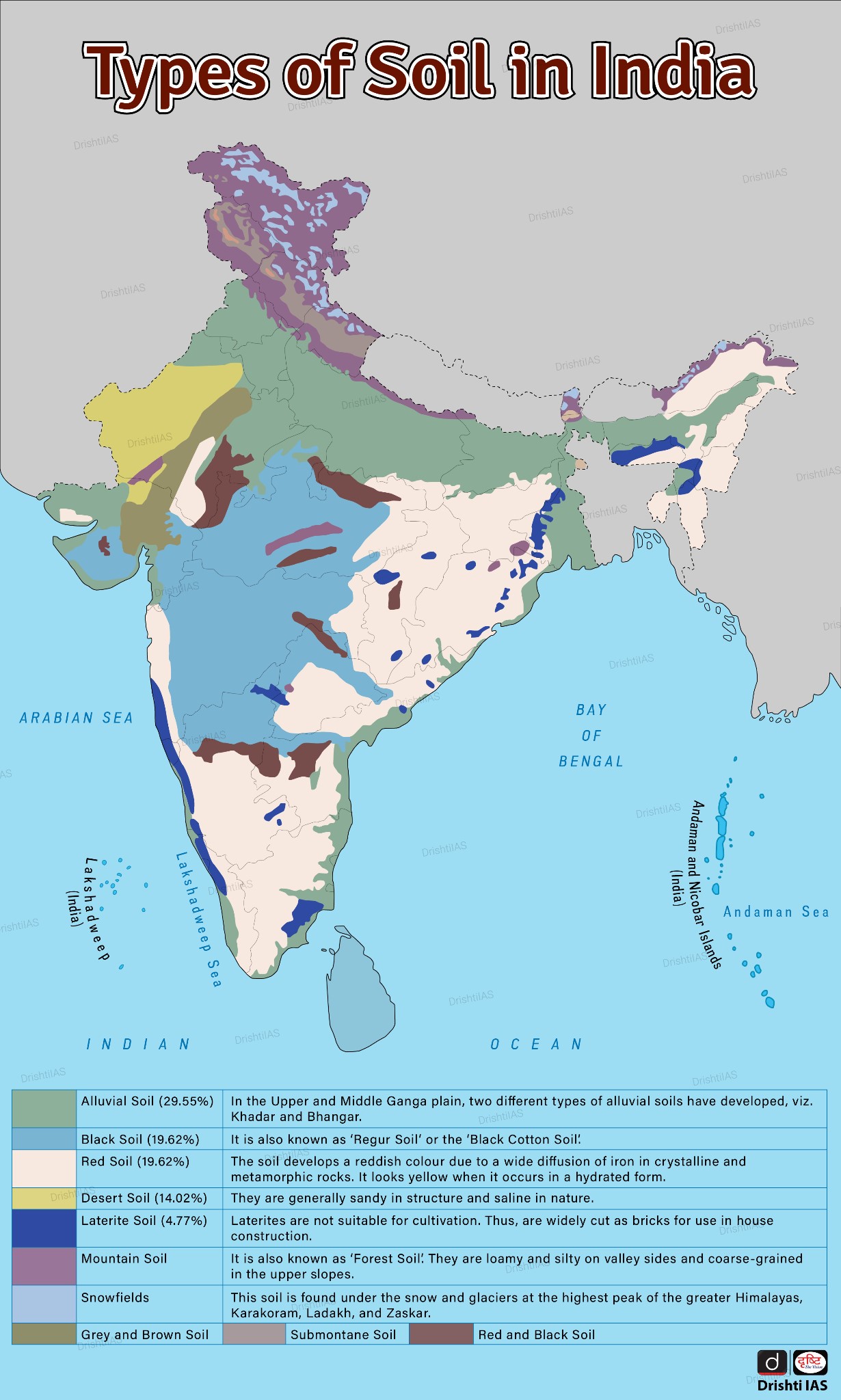10th Anniversary of Soil Health Card Scheme | 20 Feb 2025
For Prelims: Soil Health Card (SHC) Scheme, Rabi, Kharif, Organic Carbon (OC), Rashtriya Krishi Vikas Yojana (RKVY), Green Revolution, Krishi Vigyan Kendras (KVKs), Gram Panchayats.
For Mains: Role of soil health card Scheme in maintaining soil health and increasing agricultural productivity
Why in News?
The year 2025 marks the 10th anniversary of the Soil Health Card (SHC) scheme that was launched on 19th February 2015 at Suratgarh, Rajasthan.
- It helps in improving soil health and tackling soil degradation.
What is a Soil Health Card Scheme?
- About: It is a centrally sponsored scheme to assist state governments in issuing Soil Health Cards (SHCs) to all farmers across India.
- Objective: It provides farmers with information on the nutrient status of their soil along with recommendations for the appropriate dosage of nutrients to improve soil health and fertility.
- Soil samples are collected twice a year, post-harvest of Rabi and Kharif crops or when no standing crop is in the field.
- Contents of SHC: The SHC provides soil status for 12 parameters, including:
- Macronutrients: Nitrogen (N), Phosphorus (P), Potassium (K), Sulphur (S).
- Micronutrients: Zinc (Zn), Iron (Fe), Copper (Cu), Manganese (Mn), Boron (Bo).
- Other soil properties: pH (Acidity or Basicity), Electrical Conductivity (EC), and Organic Carbon (OC).
- Initiatives Under SHC:
- Village Level Soil Testing Labs (VLSTLs): VLSTLs are small, decentralized soil testing labs at local level. As of February 2025, 665 VLSTLs have been set up across 17 states.
- School Soil Health Programme: It aims to educate students on soil health and sustainability through sample collection, testing, and SHC generation.
- As of 2024, the program expanded to 1,020 schools, establishing 1,000 soil testing labs.
- Integration with RKVY: Since 2022-23, the Soil Health Card Scheme has been merged into Rashtriya Krishi Vikas Yojana (RKVY) as a component under ‘Soil Health & Fertility’.
- RKVY (2007) is an umbrella scheme for ensuring holistic development of agriculture and allied sectors.
- Technological Advancements:
- SHC Portal: For uniform generation of SHCs in all major Indian languages and five dialects.
- SHC Mobile App: For easy access to Soil Health Cards and streamline sample collection.
- GIS Integration: Automatic geo-mapping of soil samples using latitude and longitude so that all the test results are captured and seen on a map.
- Benefits of SHC:
- Improved Yield: The highest increase in yield was recorded for Bengal gram (44%) in Karnataka, followed by wheat (43%) in Karnataka, maize (30%) in Madhya Pradesh, and red gram (22%) in Maharashtra.
- Reduction in Fertilisers Use: Significant reduction in fertilizer use e.g.,nitrogen (7%), phosphorus (41%), potassium (27%) has been observed in case of wheat.
- Reduction in Pest: Pest and disease incidence reduced by 46%.
- Other Benefits: It included improved soil texture (12%), enhanced crop growth (38%), and better grain filling (35%).
|
Read more: Major Soil Types in India |
What is the Current Status of Soil Health in India?
- Unsustainable Agricultural Practices: Intensive farming, with excessive chemicals and monocropping, has caused nutrient depletion and soil acidification.
- E.g., lowered organic carbon levels in Punjab and Haryana due to the Green Revolution.
- Water Mismanagement: Over-extraction and poor irrigation, like flood irrigation, cause soil salinization and waterlogging.
- By 2050, 50% of arable land may be salt-affected.
- Overgrazing: Unregulated livestock grazing has led to vegetation loss, making soil vulnerable to erosion, particularly in arid regions like Rajasthan and Gujarat.
- Shifting Cultivation: The practice of slash-and-burn agriculture causes severe soil degradation by destroying organic matter.
- Invasive Species: The spread of invasive plant species like Lantana camara depletes soil nutrients and disrupts native biodiversity.
Way Forward
- Farmer Education: Only 57% of the farmers whose soils were tested were aware of the SHC scheme.
- Training, demos, and workshops by state agricultural universities (SAUs), and krishi vigyan kendras (KVKs) are needed for awareness.
- Enhancing Soil Testing Infrastructure: There is a need to establish at least one Soil Testing Laboratory (STL) per taluka to improve accessibility and efficiency.
- Timely Distribution of SHCs: The government must ensure that SHCs are distributed promptly, preferably in hard copy before sowing.
- Reduced time lag between soil data collection and distribution of SHC will help farmers apply recommended fertilizer doses in a timely manner.
- Installation of Israel’s Plantarray technology can be introduced that can provide real-time soil data using sensors and boosting information about soil profile.
- Incentives: Incentives and awards for farmers, Gram Panchayats, and officers promoting soil testing can boost participation.
- Recognition for green manure, vermicomposting, and organic farming will enhance soil fertility.
|
Drishti Mains Question: What is the Soil Health Card (SHC) Scheme? Discuss its objectives and significance in sustainable agriculture. |
UPSC Civil Services Examination, Previous Year Questions (PYQs)
Prelims
Q. Consider the following statements: (2017)
The nation-wide ‘Soil Health Card Scheme’ aims at
- expanding the cultivable area under irrigation.
- enabling the banks to assess the quantum of loans to be granted to farmers on the basis of soil quality.
- checking the overuse of fertilizers in farmlands.
Which of the above statements is/are correct?
(a) 1 and 2 only
(b) 3 only
(c) 2 and 3 only
(d) 1, 2 and 3
Ans: (b)
Mains
Q. Sikkim is the first ‘Organic State’ in India. What are the ecological and economical benefits of Organic State? (2018)

